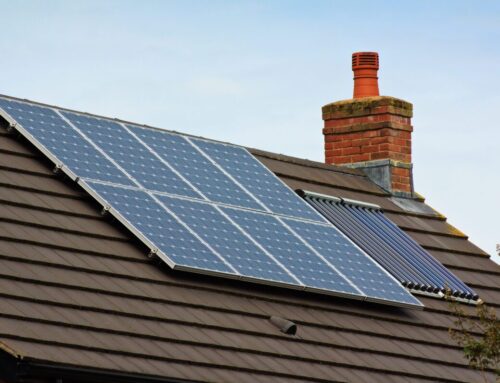Can solar energy and wildlife conservation coexist harmoniously? As solar energy becomes a prominent renewable resource, the need for wildlife conservation and the protection of animal habitats in natural habitats is equally crucial to minimize environmental impacts. The intersection of technologies and wildlife interactions presents both challenges and opportunities. Large amounts of land and disturbed lands are required for solar panel installation, which can impact natural habitats and wildlife interactions. However, innovative solutions such as fencing, resource management, and new habitats offer hope for sustainable cohabitation. In the United States, Seto et al.’s research provides valuable information on how to balance these competing needs effectively while considering various factors and measures to minimize risk and maximize positive impacts.
Exploring Solar Energy’s Environmental Footprint
Solar energy projects can have a significant impact on animal habitats and animal collisions. The installation of solar panels, wildlife fencing, and associated infrastructure can lead to habitat loss and fragmentation for various species. However, it’s essential to understand that these impacts on natural habitats are not solely negative. For instance, by repurposing degraded or contaminated land for solar installations, natural habitats and overall environmental health of the area may improve.
Collaboration between solar developers, wildlife experts, and animal measures is crucial in minimizing the potential negative impact on wildlife and natural habitats. By working together, they can identify sensitive habitats and migration corridors, and implement wildlife fencing and other measures to avoid adverse effects on local fauna. Implementing measures such as bird-friendly designs for solar installations can help reduce avian mortality.
Solar Farms as Conservation Allies
Solar installations, such as solar farms, can play a crucial role in creating new habitats for various species measures. When planning these projects, it’s essential to incorporate habitat creation into the design to benefit local wildlife. By carefully considering the layout and vegetation around solar panels, suitable habitats can be established for different species. For example, planting native grasses and wildflowers around solar arrays can attract pollinators like bees and butterflies.
Creating suitable habitats within solar farms contributes to the overall biodiversity of the area. This means that not only are existing ecosystems preserved but new ones are also being formed through careful planning and management of solar energy sites.
Collaboration with ecologists and conservationists is vital during project development to ensure that habitat creation aligns with local wildlife needs.
Species Protection
When implementing solar energy projects, prioritizing the protection of endangered species is paramount. Measures should be put in place to prevent harm or disruption to sensitive species’ natural habits due to construction or operation activities on-site. For instance, if a certain area hosts nesting grounds for endangered birds, specific precautions must be taken during site preparation and construction phases.
Collaborating with conservation organizations provides valuable insights into effective strategies for protecting vulnerable species throughout all stages of a project – from initial site selection to ongoing maintenance.
Biodiversity Hotspots
Identifying biodiversity hotspots helps guide where solar developments should take place while minimizing potential ecological impacts. Avoiding high biodiversity areas ensures that sensitive ecosystems remain undisturbed by renewable energy infrastructure development.
Analyzing Solar-Wildlife Interactions
Birds are highly susceptible to solar infrastructure due to collisions and habitat disruption. Implementing avian-friendly designs, such as using bird-safe glass or installing visual markers, can significantly reduce bird mortality risks. Conducting comprehensive bird surveys helps identify critical areas for avian conservation. By understanding the flight patterns and behavior of birds in a particular area, solar energy developers can mitigate potential hazards and protect local bird populations.
Implementing measures like creating buffer zones around sensitive habitats or avoiding construction during critical migration periods can further minimize the impact on avian species. For example, in California’s desert regions, large-scale solar projects have been designed with wider spacing between panels to allow greater visibility for birds flying through the area.
Terrestrial Challenges
Terrestrial ecosystems face specific challenges. Balancing land use requirements with conservation goals is essential for preserving wildlife habitats. Incorporating best management practices such as utilizing brownfield sites (previously developed areas) or degraded lands for solar installations minimizes terrestrial impacts while promoting land restoration.
Furthermore, integrating native vegetation within and around solar facilities creates suitable habitats for various wildlife species. This approach has been successfully implemented in several locations where native plants were used instead of non-native grasses to restore natural landscapes disrupted by solar development.
The Importance of Research
Impact Assessment
Conducting thorough research is crucial for understanding the impact of solar energy on wildlife conservation. By conducting comprehensive impact assessments, potential risks can be identified early on. These assessments help in recognizing how solar energy projects might affect local ecosystems and wildlife habitats. Moreover, they aid in developing appropriate mitigation strategies to minimize negative impacts.
Regular monitoring is essential to ensure the effectiveness of implemented measures. This ongoing evaluation allows researchers and conservationists to assess whether the mitigation strategies are successful in reducing harm to wildlife populations.
Mitigation Strategies
Effective research priorities include devising mitigation strategies that minimize adverse effects on wildlife due to solar energy projects. Techniques such as implementing wildlife-friendly fencing and managing vegetation around solar installations can significantly reduce potential harm to animals.
Collaborating with experts, including ecologists and biologists, ensures that the most effective mitigation measures are put into place. Their expertise contributes valuable insights into creating sustainable solutions that protect local biodiversity.
Long-term Monitoring
Long-term monitoring plays a pivotal role in ensuring the sustainability of conservation efforts related to solar energy development. It is necessary to continually evaluate the impact of these projects on surrounding ecosystems over extended periods.
This continuous monitoring helps identify any unforeseen impacts on wildlife and their habitats, allowing for timely adjustments or adaptations in mitigation strategies when necessary. Collaboration between solar developers, scientists, and conservation organizations remains crucial for ongoing research priorities focused on long-term monitoring efforts.
Solar Energy and Ecosystem Research
Solar energy installations have the potential to impact soil health due to changes in temperature and vegetation cover. For example, solar panels can create shading that alters the microclimate of the soil, affecting its moisture levels and nutrient cycling. Implementing soil conservation practices, such as using native vegetation or ground covers around solar installations, helps maintain ecosystem functionality by minimizing soil disturbance.
Restoring disturbed soils is crucial for promoting long-term sustainability within ecosystems affected by solar energy projects. By employing techniques like reseeding with native plants or implementing erosion control measures, researchers can contribute to the restoration of soil health in these areas.
Water Quality
Prioritizing protection of water quality in nearby water bodies is crucial for sustainable solar energy projects. Sedimentation control measures are essential to prevent runoff pollution from construction sites and maintenance activities associated with solar installations. Collaboration with water resource experts ensures effective management of water quality throughout all project phases.
By working closely with hydrologists and environmental engineers, scientists can develop comprehensive strategies aimed at preserving water quality near solar energy facilities. This collaboration contributes significantly to safeguarding aquatic habitats and supporting overall ecosystem health.
Climate Resilience
The transition to renewable energy sources, including solar, plays a vital role in mitigating climate change impacts on wildlife habitats. As part of broader climate adaptation strategies, combining solar energy development with other renewable technologies enhances overall ecosystem resilience against climate-related challenges.
Integrating science-based approaches into renewable energy planning provides opportunities for enhancing ecological resilience while meeting growing demands for clean power generation.
Enhancing Habitat Protection with Solar Development
When choosing locations for solar energy development, it’s crucial to minimize potential ecological impacts. Avoiding sensitive habitats and areas with high biodiversity is essential. By considering existing land use patterns, sustainable site selection can be achieved.
For instance, a solar project might avoid building in an area known for its diverse wildlife population or where migratory birds frequent. Instead, it could be placed in a location that has already been disturbed by human activity.
In addition to thoughtful site selection, the design of solar energy infrastructure plays a significant role in minimizing harm to wildlife and their habitats.
Design Innovations
Innovative designs can effectively reduce risks such as wildlife collisions and habitat fragmentation. Incorporating bird-safe features into solar infrastructure benefits avian species greatly. Collaboration between engineers and biologists fosters these design innovations.
For example, using materials that reflect less light can help prevent bird collisions with solar panels. Designing structures that allow animals to move freely underneath them reduces habitat fragmentation risks.
Furthermore, once solar energy projects are operational, effective management practices are necessary to ensure minimal impact on local ecosystems.
Management Practices
Implementing best management practices ensures sustainable operations of solar energy projects. Regular maintenance and vegetation management play key roles in preventing habitat degradation caused by the presence of solar infrastructure. Adhering to industry guidelines promotes responsible project management while reducing negative impacts on wildlife and their habitats.
Species Diversity Around Solar Installations
Flora and Fauna
Solar energy projects have the potential to impact local species diversity of flora and fauna. Understanding how different species interact with these installations is crucial for developing effective conservation strategies. For example, when solar panels are installed in a desert area, it can affect the habitat of certain plant species or small animals that rely on those plants for food and shelter. Collaborating with ecologists helps in preserving the local biodiversity by considering the needs of various species during the planning and implementation of solar projects.
Collaboration between solar developers and ecologists can lead to innovative solutions that minimize negative impacts on wildlife while harnessing renewable energy sources effectively. By working together, they can find ways to protect critical habitats, such as wetlands or forests, while still utilizing solar technology for sustainable energy generation.
Ecological Studies
Conducting thorough ecological studies provides valuable insights into how solar energy affects wildlife populations. These studies help identify potential risks associated with solar installations and inform mitigation measures to minimize harm to local flora and fauna. For instance, researchers may study bird migration patterns around large-scale solar farms to understand if these structures pose any threats to migrating bird populations.
The collaboration between researchers and solar developers enhances our understanding of the ecological implications of renewable energy projects. This partnership allows for proactive measures like adjusting installation designs or implementing deterrents that prevent harm to wildlife without compromising clean energy production.
Conservation Benefits
Incorporating wildlife-friendly practices within solar energy projects contributes significantly to overall conservation efforts. By combining renewable energy generation with conservation-minded approaches, such as creating pollinator-friendly habitats near solar arrays or using grazing animals for vegetation management at sites, ecosystems benefit from reduced disruption.
Renewable Energy and Wildlife Coexistence
Responsible deployment of solar energy involves considering wildlife conservation from the project’s inception. This means incorporating environmental considerations into the planning phase to minimize negative impacts on wildlife. For example, by strategically locating solar installations away from critical habitats or migration routes, we can reduce disturbances to wildlife populations.
Collaborating with environmental experts is crucial for ensuring that responsible deployment practices are upheld. These experts provide valuable insights into local ecosystems and help identify potential risks to wildlife. By involving them in the planning process, developers can make informed decisions that prioritize both renewable energy production and wildlife conservation.
Developers must also take measures to mitigate any potential harm caused by solar installations. This could involve implementing bird-friendly designs or creating safe passageways for small animals around solar arrays. By proactively addressing these concerns during the development phase, developers can minimize adverse effects on local fauna.
Scalable Solutions
Scalable solutions in solar energy development enable widespread adoption of wildlife-friendly practices across the industry. Sharing best practices and lessons learned among developers fosters continuous improvements in mitigating the impact of solar installations on wildlife.
Collaboration between researchers, policymakers, and industry stakeholders drives scalability by identifying effective strategies for coexistence between renewable energy production and biodiversity conservation efforts.
Policy Frameworks
Effective policy frameworks play a pivotal role in integrating wildlife conservation into solar energy development processes. Encouraging regulatory incentives supports responsible implementation of projects while promoting environmentally friendly practices within the industry.
Furthermore, collaboration between policymakers and conservationists strengthens policy frameworks by aligning regulations with biodiversity preservation goals.
Collaborative Efforts for Preservation
Stakeholder Engagement
Engaging local communities, NGOs, and indigenous groups is crucial for successful solar projects. By involving these stakeholders in decision-making processes, concerns can be addressed effectively. Diverse perspectives contribute to more well-rounded project outcomes.
Incorporating the input of various stakeholders ensures that the solar energy projects take into account the needs and concerns of all involved parties. For example, when planning a new solar farm, consulting with local community leaders and environmental organizations can help identify potential impacts on wildlife habitats or migration routes.
Community Involvement
Involving local communities in solar energy projects is vital for fostering support and acceptance within those areas. Engaging communities in conservation initiatives not only promotes environmental stewardship but also encourages a sense of ownership over the renewable energy efforts taking place in their vicinity.
By collaborating with community leaders and organizations, solar energy developers can ensure that local knowledge about wildlife habits and movement patterns is considered during project planning. This collaboration helps minimize negative impacts on wildlife while maximizing benefits to both the environment and local residents.
Conservation Partnerships
Building partnerships with conservation organizations plays a significant role in enhancing wildlife conservation efforts alongside solar developments. These collaborative ventures allow for the pooling of expertise and resources to achieve better outcomes for both renewable energy initiatives and wildlife preservation.
Joint initiatives between solar companies and conservation groups facilitate innovative solutions that integrate sustainable practices into project designs. An example includes creating “wildlife corridors” within solar farms to provide safe passages for animals without disrupting their natural behaviors.
Addressing Challenges in Renewable Conservation
Habitat Fragmentation
Solar energy projects can contribute to habitat fragmentation. This occurs when large areas of land are cleared for solar installations, disrupting the natural habitats of wildlife. To minimize this impact, strategic project design is crucial. By carefully planning the layout and location of solar panels, developers can reduce the disruption to wildlife habitats. Incorporating wildlife corridors into project designs helps maintain ecological connectivity by providing safe passages for animals to move between fragmented habitats.
For example:
- In California’s Mojave Desert, solar developers have worked with conservation organizations to identify and protect critical wildlife corridors while planning solar projects.
Sensory Disturbances Another challenge is the sensory disturbances caused by solar installations. These disturbances include noise, light, and electromagnetic fields that can affect certain species’ behavior and well-being. Understanding these impacts is essential in mitigating them effectively. Implementing measures such as sound barriers or using low-glare panels can help minimize sensory disturbances and protect wildlife in the vicinity of solar energy sites.
Climate Change Factors
The transition to renewable energy, including solar power, plays a vital role in reducing greenhouse gas emissions that contribute to climate change impacts on wildlife habitats. By decreasing reliance on fossil fuels, renewable energy aids in preserving species’ ranges and migration patterns which are affected by changing climates.
Frequently Asked Questions
How does solar energy impact wildlife conservation?
Solar energy can have both positive and negative impacts on wildlife conservation. While it helps reduce greenhouse gas emissions, the construction of solar farms can disrupt habitats. Research is vital to understand these interactions and develop strategies for coexistence.
What are the benefits of using solar farms for conservation?
Solar farms can act as allies in wildlife conservation by providing habitat restoration opportunities, enhancing biodiversity, and promoting sustainable land use. They offer a chance to integrate renewable energy production with ecosystem protection, contributing to a more balanced environmental approach.
What types of collaborative efforts are important for preserving wildlife in the context of renewable energy?
Collaborative efforts involve partnerships between renewable energy developers, conservation organizations, researchers, and policymakers. By working together, they can address challenges such as minimizing habitat disturbance and developing best practices that support both renewable energy goals and wildlife preservation.
How do solar installations contribute to species diversity around their vicinity?
Solar installations often create diverse microhabitats that attract various species. The open spaces beneath panels mimic natural clearings or grasslands that provide opportunities for different plants and animals to thrive. This diversity contributes positively to local ecosystems.
What challenges need addressing when it comes to conserving wildlife in relation to renewable energy development?
Challenges include mitigating habitat fragmentation caused by large-scale developments like solar farms, reducing collision risks for birds near installations, balancing land use priorities effectively while considering ecological impacts, and ensuring long-term monitoring of potential effects on local fauna.


 Solar Company
Solar Company 



